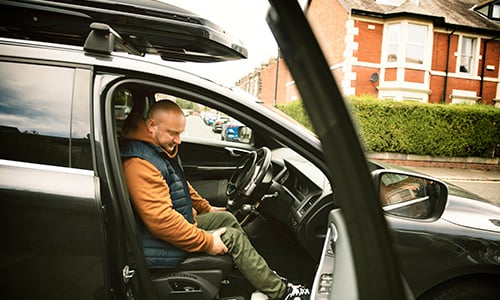Driving is a freedom we typically do not associate with people who have a spinal cord injury. However, with the proper precautions, training, and vehicles with adaptive equipment, it’s definitely within reach of most SCI survivors.
There is no question driving has the ability to offer us a freedom unlike any other we enjoy. Whether traveling to pursue everyday activities or hitting the open road, driving is a privilege full of possibilities and, quite often, adventure.
For sufferers of spinal cord injury, specifically those who experience paralysis, one may wonder if the days of driving are behind you. The purpose of this article is to inform you of things people living with a spinal cord injury should consider if entertaining the idea of getting back behind the wheel.
Driving will never be the same.
While the rules of the road remain the same, how you interact with your vehicle and, therefore, the road itself, will be drastically different from what you may be used to. Depending on one’s specific injury and needs, the vehicle you drive may include, but not be limited to, any of the following:
· Hand controls for braking and accelerating
· Power assist devices for easy steering
· Touch ignition pads and gear shifts
· Adjustable drivers’ seats
· Joysticks or spinner knobs for those with limited hand function
While each of these controls needs to be learned and mastered before getting back out on the road, they do demonstrate the wide range of adaptive controls and modifications that exist specifically for the benefit of people living with an SCI.
Driving with an SCI begins with evaluation.
The first step in the process of relearning to drive with SCI is to obtain an evaluation from a qualified driver trainer. Not only will they help you determine the proper driving setup and specific vehicle modifications and equipment necessary for your unique situation, but they’ll also assist in evaluating you on the following, all of which are necessary for safe driving:
· Vision screening and muscle strength
· Flexibility and range of motion
· Hand-eye coordination and reaction time
· Judgment and decision-making
· Ability to handle adaptive equipment
· Evaluation of any medications the driver takes or will take
Of course, even after evaluation, one must adhere to the rules and regulations of the state and location in which one resides. Not all spinal cord injury individuals will be eligible to drive again, purely because of the nature of a spinal cord injury and the lack of distinctive cure. Most states require a valid learner’s permit or driver’s license to receive an on-the-road evaluation. You cannot be denied the opportunity to apply for a permit or license because of your disability, but do know you may receive a restricted license based on the adaptive devices you require.
Selecting your vehicle
As a driver living with a spinal cord injury, an important thing to remember in choosing a vehicle is that it should be one that best suits your abilities and needs. For example, a minivan, which offers more room and may be easier to get into and out of, may be more practical than a two-seater sports car.
Other things to consider are whether you will be sitting in your wheelchair while driving or will you transfer yourself to a seat. If the former, your vehicle should be equipped with wheelchair lockdown equipment for your safety. Power lockdown units are easier and allow for more independence, whereas manual systems often require other people to help you get in or out.
There are plenty of other tips and questions you should be asking yourself as you search for the vehicle that best matches your spinal cord injury needs. Will you fit in a minivan? Can your vehicle accommodate hand controls or other needed equipment? Once the vehicle has been modified, will there be enough room for passengers? If using a technician to modify an existing vehicle, does he/she have the requisite experience?
As you can see from the above, there is much to think about while considering the proper vehicle for your condition. That’s why it’s always wise to lean on the expertise available to you from driving evaluators, your rehabilitation center or team, and even others who share effects of spinal cord injury similar to those that you experience.









